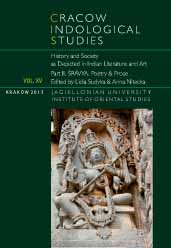Women’s Town—Ghost Town: A Picture of a Dying City in the Raghuvaṃśa
Women’s Town—Ghost Town: A Picture of a Dying City in the Raghuvaṃśa
Author(s): Tomasz WiniarskiSubject(s): Cultural history
Published by: KSIĘGARNIA AKADEMICKA Sp. z o.o.
Keywords: Raghuvaṃśa; kāvya; female protagonist; Śrī; Ayodhyā
Summary/Abstract: The following article analyses the passage of Kālidāsa’s Raghuvaṃśa 16.4–24. The focus is on the image of a dying city—how it is portrayed and what makes Kālidāsa’s depiction so distinctive. The author’s main interest is in the role of the female characters in the description: who they are, why they and their activities are chosen to serve as a mirror reflecting the city condition. The importance of Śrī and her connection to female citizens and the city itself is analysed. Also the relation of “ masculinity” and “femininity” and the role it plays in the process of deconstructing/reconstructing the city and the reality is analysed. Next, the article briefly deals with the relation between the real and unreal in the text, how they interplay and what the role of narrating the story and retelling the reality for the above-mentioned process of city deconstruction/reconstruction is. The Sanskrit text translation is given in the appendix.
Journal: Cracow Indological Studies
- Issue Year: 2013
- Issue No: 15
- Page Range: 37-66
- Page Count: 30
- Language: English

